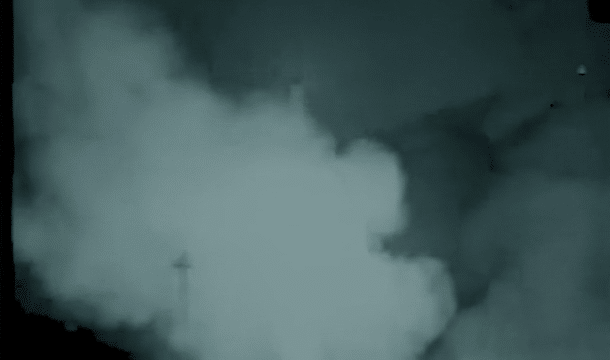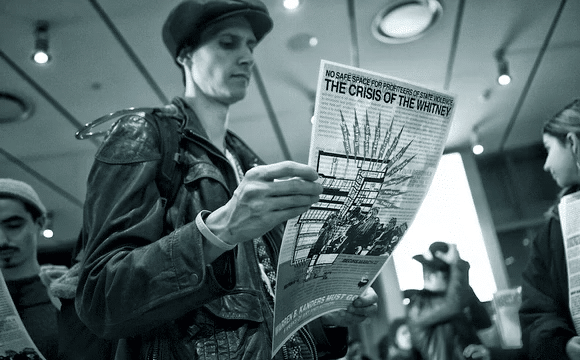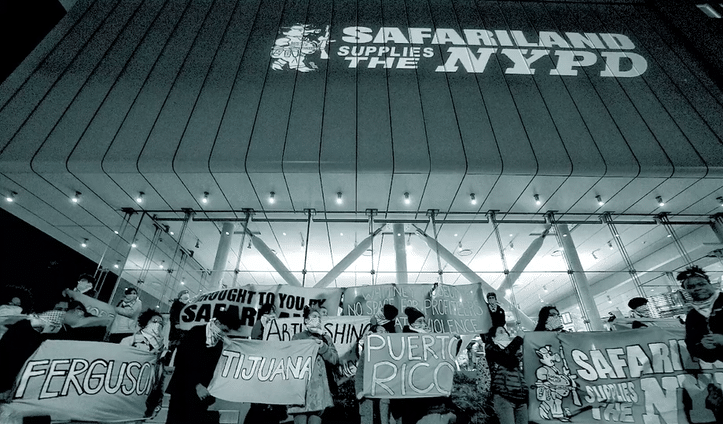Introduction: In the Presence of Others
Nicholas Gamso & Jason Fox
Reality is what we make of it—at least in principle. So argued Hannah Arendt, the political philosopher whose brilliant and sometimes troubling ideas frame the many contributions gathered in this issue of World Records. Arendt returned again and again to her core philosophical concern: a common world experienced in the presence of others. In Arendt’s estimation, to recognize one another, and to do so on equal terms, was an essential human practice. “The reality of the public realm relies on the simultaneous presence of innumerable perspectives and aspects,” Arendt writes in The Human Condition, “in which the common world presents itself and for which no common measurement or denominator can ever be devised.”{1} When such a world appears, humans are no longer forced to accept the givenness of reality. Suddenly, they may realize their own capacity to make it anew.
This issue of World Records investigates how documentary film and video, performance art, curatorial frameworks, digital social media platforms, and photojournalism provide grounds for collective action. Arendt’s writings on modern politics frequently emphasized the attenuating effects of mass media on public life. But she didn’t think it had to be that way, for Arendt believed critical journalism to have real value. Her own Eichmann in Jerusalem stands as a significant documentary report in its own right, one which attests to the power of collective judgment. It’s just that, as she observed in Eichmann, mass mediation technologies were too often mistaken by modern governments as solutions to the difficulties, digressions, and disagreements that necessarily arise from political interaction.
Media, Arendt thought, is way more than just messages. Media becomes a useful concept when it is recognized for its role in conducting and binding worldly relationships, thus modeling democractic processes. Consider Arendt’s analogy: “a world of things is between those who have it in common, as a table is located between those who sit around it.” The table facilitates the relational form of political life. She continues, “the world, like every in-between, relates and separates men at the same time.”{2} The indeterminate role Arendt assigns to media, a term that could refer to any number of infrastructures that simultaneously relate and separate people, upsets more normative ideas within liberal discourse—namely one that understands media as a neutral means of representation, transparency, or the production of group sentiment. Liberal appeals to technological progress to solve human afflictions assumes that mediation will not interfere, or be made to interfere, with the transmission of messages. Such faith proves, in Arendt’s words, “simply unrealistic.”{3}
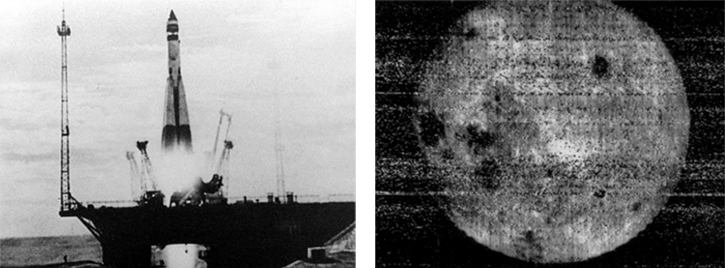 Figure 1. (L) Sputnik 1 launches on October 4, 1957. (R) The far side of the moon, as pictured by Luna 3, October 1959. Why is it, Arendt wondered in the prologue to her THE HUMAN CONDITION, that at the same moment humans were literally demonstrating their capacity to transcend terrestrial limits, so many were also expressing a banal deference to capitalism’s claims to technological efficiency as the ultimate source of
freedom?
Figure 1. (L) Sputnik 1 launches on October 4, 1957. (R) The far side of the moon, as pictured by Luna 3, October 1959. Why is it, Arendt wondered in the prologue to her THE HUMAN CONDITION, that at the same moment humans were literally demonstrating their capacity to transcend terrestrial limits, so many were also expressing a banal deference to capitalism’s claims to technological efficiency as the ultimate source of
freedom?
Arendt’s commentary appeared in the mid-century context of emerging computational and mass communication technologies. The celebration of these technologies, epitomized for Arendt in the overarching narratives of the Cold War, expressed a banal deference to the narrative of progress in the resolution of social ills. Arendt lamented the ways totalitarian regimes and corporate power seekers alike put such deference to use in the decades to follow. Their desire to instrumentalize, possess, and control provided the background for Arendt’s conviction that what counted as realism was in fact the numbing of humans’ political imaginations. Despite the potential of public life to reconstruct the world, in Arendt’s regretful analysis, the world itself—the modern world, which Arendt experienced personally as a series of expulsions and border crossings—seemed beyond repair.
Forty-five years after her death, as digital technologies have become the in-betweens of so much of our intimate, social, and political lives, we believe that the apparent contradiction between her philosophy and the facts of her life renews the purchase of Arendt’s ideas today.{4} The particular conditions at the moment we write this introduction—physically distanced from others and all the more reliant upon digital telecom platforms that heighten race and class stratifications between irl and url workers—puts the stakes of these investigations into sobering relief.
****
Documentary Conditions
Documentary needs a public, but defining public is a vexed business for scholars and citizens alike. Jonathan Kahana was one of the first documentary theorists to engage Arendt’s understanding of the public as a sphere of conflict and comparative experience. Kahana remarked that a lack of engagement with Arendt was odd, since Arendt’s approach to publics “brings together the themes of reality as a social construction, of human labor as an art form from which a life-world is shaped, and of the agency of collective thought and perception.”{5} Arendt argued that the social and political conditions through which people recognize themselves as constituent parts of an imaginary are expressed “through sensible medium(s) of public experience.” {Article 5} Updating Arendt’s assertion, Kahana moved beyond the immediate space of the town hall meeting to the ways in which documentary becomes a constitutive public experience.
Arendt’s conviction that reality is a fundamentally aesthetic and social phenomenon forged by collective action offers a dynamic approach to the making and reception of documentary media. As Kahana argued, Arendt’s attention to collective labor was considerably more generative than the model of individual consciousness associated with the American progressive school of public opinion, which emerged to address anxieties about mass culture during an early twentieth century period of rapid urbanization and population growth. Modern progressive thinkers saw documentary as a corrective to mass commercial entertainment, piecing together a rational world outside the Hollywood fantasies and sensational newspaper columnists. Documentary, so one narrative goes, models rational citizens by presenting them with empirical evidence of the world around them.{6} Arendt, by contrast, re-envisions social action away from rational, linear movement, and towards improvisatory, intersubjective experience of shared worlds. Her ideas thus provide auspicious grounds for thinking about the relationship between documents and democracy.
Documentation does not simply index the real through representation. Rather, it provides an ensemble of practices through which a public can shape and deliberate meanings and effects. When and where this occurs—in groups of two, twenty, or twenty million—a public can be said to have formed. “Nothing (can be) public about the members of a public,” Kahana argued, until they self-consciously consider the technological, thematic, and aesthetic terms that have brought them together, and what uses might be made of them.{7} Documentary objects such as photos and films should be understood as contested artifacts with multiple, contingent meanings that emerge in a productive tension with particular social and cultural conditions. In the space between making and meaning—the struggle against the managers of meaning and the bonds that are forged by those linked in that struggle—is where one finds politics.
“The event of photography is never over” is the way media theorist Ariella Aïsha Azoulay refers to this ongoing struggle.{8} In direct conversation with Arendt’s writing, Azoulay argues that documentary images can forge a “civil contract” between spectators and photographed people when photographic discourse suspends a dominant viewpoint (in Azoulay’s case that of the Israeli state) and offers a perspective outside of the sovereign categories such as citizen or refugee. Azoulay’s admonition does not dissolve these distinctions. It only proposes a potential space to redress them through forms of imagination and solidarity that state-based citizenship categories do not allow.{9}
Photographs provide a common set of objects around which spectators may express critical judgments and thus position themselves with regard to what they are witnessing. By self-consciously drawing comparisons to shared conditions, viewers of photography illustrate Arendt’s observation that to judge is to generalize—and individual judgments may become political because they generalize. Judgment forces viewers to make determinations about particular content and to place that content in a broader social and historical framework.
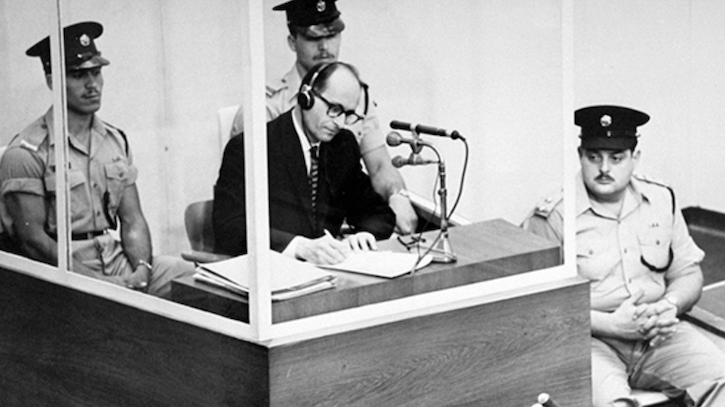 Figure 2. Adolf Eichmann on trial in Jerusalem in 1961.
Figure 2. Adolf Eichmann on trial in Jerusalem in 1961.
Arendt thought judgment to be the pinnacle of political activity. She also thought it disastrous how quickly people relinquished their willingness to judge. It was to such anesthetic effect, as Kahana’s essay argues, that Arendt believed Israeli prime minister David Ben-Gurion mounted the 1961 trial of the Nazi “architect of the Final Solution” Adolf Eichmann. Arendt’s well known “report on the banality of evil” found that Eichmann’s cold disinterest was at every step legal and that Eichman himself was something of a stand-in for the actually quite widespread and bureaucratic responsibility for the genocide of European Jews. By insisting on the narrative of Eichman’s bad conscience, Ben-Gurion relinquished the fledgling Israeli state’s capacity for rational judgement. The prime minister was thus freed to author a national origin story, grounding state power in the fiction of retributive justice. “Only good people are ever bothered by a bad conscience,” Arendt later reflected with mordant insight.{10} Evil is constructed in the image of a singular foe.
In her commentary on Ben-Gurion, Arendt decried what she saw as the use of Jewish identity to secure political legitimacy and to exclude the Arab majority from governing. Arendt was appalled by the evocation of affinity—what she describes as an ethic of “like attracts like”—as the foundation of a political community. Talk of empathy in politics also concerned Arendt because it privileges citizens’ individual moral investments in the suffering of others at the expense of the deliberative political judgments that might reduce suffering or find means of doing justice.{11}
THE VIEWING BOOTH (Ra’anan Alexandrowicz, 2019).
The form of judgment that Arendt advocates presupposes a community of equals who share and critique each other’s claims and opinions. In The Viewing Booth (2019), filmmaker Ra’anan Alexandrowicz stages a conversation between himself and Maia Levy, a Temple University student, concerning videos recorded in the context of the Israeli occupation of Gaza and the West Bank. Alexandrowicz is interested in how “we try to find our own position in the world through critical engagements with the images and sound that portray that world.” {Article 02} Yet, when asked to narrate her reactions to video fragments produced within the context of contested Israeli settlements, Levy avoids imagining “a wider image that includes the occupation.” Instead, Alexandrowicz argues, she “discovers the person shooting, the camera, the memory card, which was transferred to the human rights organization, the computers that were used to post the video online.” In other words, she discovers the videos’ construction, and from that construction, she infers that the imagery is meant to deceive, and is thus too political. By dismissing the videos as too constructed to take seriously, she is also able, in an Arendtian sense, to dismiss her civil responsibility.{12}
Groupthink defines itself against strangers and newcomers, grounding political belonging in the specter of what Miriam Ticktin refers to as the trope of “invasive others.” {Article 11} As Ticktin argues, depicting migrating peoples with either anxious distrust or sympathetic moral investment structures xenophobic hostility and its progressive twin, humanitarian sentiment. Ticktin sees documentary as a space to do battle against invasive images. She praises the Syrian film collective, Abounaddara, for “challenging the visual and affective vocabularies of humanitarianism,” and refusing “affective responses such as pity or compassion.” In lieu of such representational clichés, the group asserts the “right to a dignified image” to reclaim some of the aesthetic terrain of politics. Reclamation will always remain an open project, for it resides in the space of media and it is subject to the indeterminacy that exists in relation between people.
****
The Location of Politics
Politics necessitates judgment, but political activity does not necessarily equate to justice. Arendt’s celebration of agonistic dramas of political life over specific ideological content raises serious concerns about whether her ideas can address questions of racial and economic justice.{13} Because our interest in Arendt is hardly disinterested, we echo a concrete example celebrated by Arendt for the glimpse of transformational politics it offered. The Communards of the short-lived Paris Commune of 1871 had a maxim which they used to guide their revolutionary pedagogy in pursuit of a society shaped by equal political participation: Everything is in Everything. From that principle followed a few others. Everyone is capable of connecting the knowledge they already have to new knowledge. Everyone is of an equal intelligence. Learn something and relate everything else to it. The Communards realized not that everything was political, but that anything could be the starting point for politics once they reflected upon how objects and conditions mediated their social relationships. As the political theorist Bonnie Honig observes, nothing is intrinsically political in Arendt’s outlook, but neither is anything protected from being politicized. Issues become political when they are mediated, or made to appear in public.{14} The Communards, like Arendt, saw political emancipation as possible only when “the universe of daily experience becomes translatable.”{15} Media provides a means of translation between many minds, bridging the interior life of an individual and the world in which she lives. Political equality—the equal right to appear before others and to disrupt power’s monopoly on expression—is the project of media’s relational character.
Political equality operates through what Arendt calls the right to have rights—the basic human right to act as a political agent in shaping a common world. The right to have rights exists everywhere, though it’s typically only fulfilled (and only for a few) by the liberal nation-state {Article 12}. Arendt’s construction illustrates the power of the speech act—the convocation of politics through the assertion of rights—and a normative idea of the moral good, which allows entities to exist in dynamic relation to one another. But what she didn’t think is that simply shouting I am free would then make it so. It’s more that she thought that given a choice, it would be better to rely on collective will rather than a beneficent ruler to secure one’s freedom. She then sought to define the conditions that make possible mutual regard, deliberation, and collectivity.
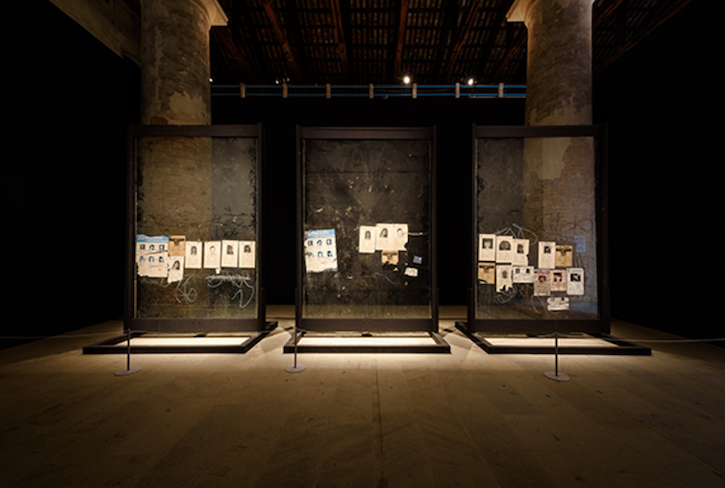 Figure 3. LA BÚSQUEDA (The Search) (2014), by Teresa Margolles, installed at the 2019 Venice Biennial. Sound frequency on three glass panels transported from the historical centre of
Ciudad Juárez, Mexico. Image courtesy of James Cohan Gallery.
Figure 3. LA BÚSQUEDA (The Search) (2014), by Teresa Margolles, installed at the 2019 Venice Biennial. Sound frequency on three glass panels transported from the historical centre of
Ciudad Juárez, Mexico. Image courtesy of James Cohan Gallery.
In these pages, several authors appeal to the right to have rights in order to consider representations of and by those who have been expelled from an existing political framework. Cecilia Sjöholm, for example, discusses the specter of border violence and the rights of the dead, arguing, in an analysis of works by the Mexican artist Teresa Margolles, that new visual strategies for asserting lost personhood, as opposed to the convention of numerical records of mass disappearance, can radically alter our understanding of political violence in the world. {Article 13} For Rayya El Zein, communities long denied national sovereignty can find new means to conceive of a politics around diasporic cultures of loss and remembrance. {Article 4} Her discussion of the Palestinian Right to Return explores the layers of meaning and experience that make such a politics possible. El Zein cites Jacques Rancière’s critique of Arendt— specifically his argument that human rights is something of an open work to be fulfilled through relational activities—and thus explores the political potential that resides in expressions of dispossession across the Palestinian diaspora. Then turning to the work of media artists Basel Abbas and Ruanne Abou-Rahme, she articulates how such an aesthetics of diasporic recovery might be visualized.
Politics, El Zein and Sjöholm make clear, are always particular to place and time. And it is particularity that is missing from an Arendtian approach to politics as a “relationship of simultaneous difference(s) and interdependence(s).”{16} Arendt’s approach is useful because it is general, but it is only useful when it is applied within the particular economies that shape politics. The events that characterize the political economy in which we assemble this issue include escalating opposition to police violence against people of color, an expanding security state, and the ongoing occupation of Palestine.
 Figure 4. From ONLY THE BELOVED KEEPS OUR SECRETS (Basel Abbas and Ruanne Abou-Rahme, Palestine, 2016).
Figure 4. From ONLY THE BELOVED KEEPS OUR SECRETS (Basel Abbas and Ruanne Abou-Rahme, Palestine, 2016).
In this context, Arendt’s many conservative writings on American racial politics, poorly justified with strict boundaries as to what counts as political action, were decidedly unreceptive to economic or social analysis. Arendt wished to distinguish action (where she locates politics as displays of personal and collective agency) from labor (which gives life to human populations) and work (which builds and maintains the shared world we inhabit) in order to preserve a meaningful space for private life. Public life is the site of action, private life and an intermediary social sphere are where work and labor take place. This hierarchy provided the basis for Arendt’s well-known critique of feminism and Black liberation movements both, which she held to be politically unsound because they brought private life into the public realm. We follow authors Bonnie Honig and Seyla Benhabib in arguing that Arendt’s evident disdain for social movements needs to be reconceived as a call to politicize our understanding of feminism and racial capitalism. Arendt’s evident anti-blackness—including her resistance to the integration of US schools on grounds that schools are part of the social rather than public realm—might also be taken as grounds for correction, an idea which Arendt acknowledged in a well-known exchange with the novelist Ralph Ellison, expressing regret for her failure to “understand the complexities of the situation.”{17}
****
Politics and the Cultural Economy
To some readers, Arendt’s belief that politics comes before social concerns like labor and reproductive issues renders her arguments mostly irrelevant to this particular moment.{18} Others find Arendt eminently useful to track the dissolution of the boundaries between culture and politics and between private and public life in the neoliberal age. The autonomist philosopher Paolo Virno, who argues that “labor has acquired the traditional features of political action,” falls into the latter camp.{19} He wonders: If capital can parcel speech, action, and collective experience just as easily as it does pasture, how can we create space for anti-capitalist politics? And, are too many of us too busy performing creative labor as content producers of one form or another to provide an audience for others’ speech?
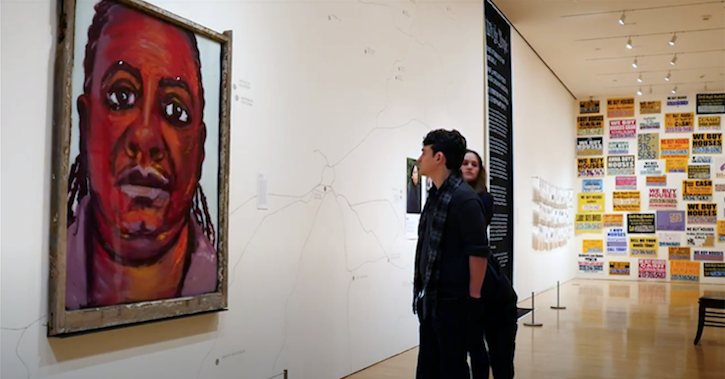 Figure 5. at Philadelphia ASSEMBLED (2017), Jeanne Van Heeswijk’s multi-year social practice project at the Philadelphia Museum of Art involving hundreds of Philadelphia-based artists and groups. Image courtesy of Martin Lucas.
Figure 5. at Philadelphia ASSEMBLED (2017), Jeanne Van Heeswijk’s multi-year social practice project at the Philadelphia Museum of Art involving hundreds of Philadelphia-based artists and groups. Image courtesy of Martin Lucas.
Several essays in this volume consider the potential—something of a recurring theme in the avant-garde tradition—for creative actions to subvert their status as labor and recuperate political meaning. Filmmaker Martin Lucas, starting from the idea that “what we live with now is a world where our creativity is where capital derives value,” {Article 3} turns to site specific social practice projects of artists Jeanne van Heeswijk and Tania Bruguera. Van Heeswijk makes use of the surplus cultural capital contemporary art museums provide to chart sustainable futures away from capital’s reach. Along the way, she also frames how cultural institutions too often exhibit the lifework of people of color as artwork within the museum walls.
Recent museum demonstrations organized by Decolonize this Place — including at America’s most prestigious monuments to image culture, such as the Whitney Museum and MoMA—pose a similar set of questions, revealing not only the extent to which imperial and economic violence are embedded in the production of culture, but also the ways that culture is frequently leveraged to conceal the violence that underwrites their work. “Physical, worldly in-between(s)” like museums and monuments are “overgrown” by the social relationships, including racial exclusion, tokenism, and extractive investments that these institutions sustain.{20} The project of Decolonize this Place is not simply to disclose what lies behind the boardroom door—although such admissions are integral to their actions. The goal is rather to make visible the global framework of financialized settler colonial violence hidden in plain sight. {Article 07} Arendt’s work helps us to see how financialization compromises art institutions’ commitments to public knowledge.{21} Yet her ideas can also help us understand how the contingent and variable nature of public life—exemplified by the broad coalition involved in the Whitney protests—can turn museums themselves into arenas for critical demonstration and direct action.
Extending this thought, Bonnie Honig argues that the place of action in the modern world is often difficult to identify. Politics may indeed emerge in any kind of space or any form of activity, as the labor, feminist, and abolitionist movements have proven beyond doubt. But other arenas, those which bill themselves as the widest possible public sphere, offer no such assurances. Social media offers a sense of individual agency within a community of others, but private social media platforms, Warren Sack, Jenny Reardon, and Honig argue, cannot make a citizenry out of users. {Article 10} More generative spaces for politics might exist away from the glare of such nominal public exposure. Political theorist Seyla Benhabib sees the distinction between labor and action, and between the poles of social and political life, as soft oppositions rather than as discrete items ordered à la carte: “a private dining room in which people gather to hear a Samizdat or in which dissidents meet with foreigners,” as Benhabib observes, “becomes public space if they are the object and the location of an ‘action held in concert.’”{22} The metaphor of the shared table warrants special attention because it evokes the themes of scarcity and abundance, of domestic labor, all the activities associated with private life. The table operates as more than a political centerpiece, in other words. It is the culmination of reproductive action, a symbol of necessity fulfilled.{23}
Media, in its expansive sense, traverses public and private life, combines reproductive labor and action, and condenses social and material conditions. Media binds, but it shouldn’t homogenize. Scholar and filmmaker Nitasha Dhillon emphasizes this point by addressing the shortcomings of the Occupy Wall Street (OWS) rallying cry, “we are the 99%.” {Article 6} Although OWS is celebrated for showing how the neoliberal credit economy harms actors from across social and institutional life, expressing this simple majority risks erasing how harm is dispersed unevenly across race, class, and gender. In Dhillon’s view, occupiers can only forge the necessary solidarity to challenge a global financial system once occupiers acknowledge and honor the “horizontal debts that we owe to each other as a result of the legacies of colonization and enslavement.” In other words, collective action is made possible by tending to the realms of labor and work—to the uneven forms of socialization and social reproduction that structure real differences among the 99%. Debt comes in many forms. Its violence marks people unevenly. Drawing connections between such differences, understanding how they play out at various levels of lived experience, and organizing through rather than around them, is what sustains shared trust in mutual life. Without such a trust, Arendt argued and Dhillon echoes, it is impossible to act politically in and with the presence of others.
****
A Note on Method
For reasons outlined above, we believe that Arendt’s persona has at times obscured her arguments—a critique that we suspect Arendt herself would approve, given her embarrassment at personal notoriety. She was adamant that “no common denominator” should ever be devised that precludes individuals from participating in a space of political decision making—no affiliation, no specific background or experience, no ways of knowing. As a result, some of the contributors to this issue demonstrate the riches that come with close readings of Arendt. Other contributors engage her work obliquely, through secondary interlocutors, and some engage with core concerns of Arendt without mentioning her own writing at all. What these essays share is a commitment to thinking politically across documentary art and media in the pursuit of a world worth having.
Background Video: Triple Chaser (Forensic Architecture Lab, UK, 2019) / Sputnik 1 Launch / The Viewing Booth (Alexandrowicz, 2020) / Images courtesy of Decolonize this Place.
{1} Hannah Arendt. The Human Condition (Chicago: University of Chicago Press, 1958), 52.
{2} Arendt, Human Condition, 48.
{3} Arendt, Human Condition, 168.
{4} Arendt, in fact, was something of a connoisseur of contradictions. Where one finds them, she thought, one finds the most basic perplexities of living with others in equality. The oblique compliment she once paid the writing of Karl Marx, that “such fundamental and flagrant contradictions rarely occur in second-rate writers; in the work of the great authors, they lead into the very center of their work,” applies equally well to the competing Arendts that appear across her pages.{5} Jonathan Kahana, Intelligence Work: The Politics of American Documentary (New York: Columbia University Press, 2008), 19.
{6} For an example of this line of thinking, one might look to John Grierson’s “First Principles of Documentary” (1932-1934), its concern with “progressive and regressive forms of modernism,” and the ways it inherits Walter Lippmann’s view of mass mediation as a process and an effect characterized by misinformation and distraction.
{7} See Kahana’s “Arendt in Jerusalem: Documentary, Theatricality, and the Echo of Irony” in this volume.
{8} Ariella Azoulay, The Civil Contract of Photography (New York: Zone Books, 2008).
{9} In a different context but similar spirit, Fred Moten and Stefano Harvey put it this way: “The coalition emerges out of your recognition that it’s fucked up for you, in the same way that we’ve already recognized that it’s fucked up for us.” Fred Moten and Stefano Harney, The Undercommons: Fugitive Planning and Black Study (Wivenhoe, New York: Minor Compositions, 2013), 140.
{10} Hannah Arendt, and Jerome Kohn. “Thinking and Moral Considerations,” in Responsibility and Judgment (New York: Schocken Books, 2003) 161.
{11} Hannah Arendt, “Reflections on Little Rock,” Dissent 6:1 (Winter 1959): 50.
{12} Azoulay writes that “When a speaker’s preference is for political art, she might criticize a political work for being “not political enough,” consigning it to the pole of lack for demonstrating an excess of the aesthetic. Similarly, when the preference is for art that does not yield to political considerations and that treats art itself as its explicit focus, an excess of “the political” will be deemed a defect. These judgments of taste achieve three things: 1. They determine the character of the image under discussion: “aesthetic” or “political.” 2. They point to the resultant success or failure of the image. 3. They express the affinity of the speaker of the judgment of taste for work that identifies with one or another side of the opposition.” Ariella Azoulay, Civil Imagination: A Political Ontology of Photography (New York: Verso Books, 2013).
{13} One might look to one recent launderer of Arendt’s writing, Samantha Power, the former U.S. Ambassador to the United Nations who invokes Arendt’s The Originis of Totalitarianism to justify the American war on Islam, in order to see how easily Arendt’s writings on democracy are reduced to banalities about liberal tolerance and attendant forms of racial violence. See Powers’ forward to the 2004 Schocken Books reprint of Arendt’s The Origins of Totalitarianism.
{14} Bonnie Honig, “Toward an Agonistic Feminism: Hannah Arendt and the Politics of Identity,” in Feminist Interpretations of Hannah Arendt (University Park, PA: Penn State University Press, 1995), 135–166.
{15} Kristin Ross, Communal Luxury: The Political Imaginary of the Paris Commune (New York: Verso Books, 2015), 77.
{16} Patchen Markell. “Arendt’s Work: On the Architecture of The Human Condition,” College Literature 38, no. 1 (2011): 34.
{17} As Katherine T. Gines has argued, although Arendt amended her views of the Little Rock case on the basis of Ellison’s rebuke, she nevertheless repeated a variation of her misguided thinking in subsequent writings on civil rights in education, particularly in her writings “The Crisis in Education” and On Violence. See Gines, Hannah Arendt and the Negro Question (Bloomington: Indiana UP, 2014), 22.
{18} See, for example, Martha Rosler’s Culture Class (Berlin: Sternberg Press, 2013), 144.
{19} Paolo Virno, A Grammar of the Multitude: For an Analysis of Contemporary Forms of Life (Los Angeles: Semiotext(e), 2004) 51.
{20} Arendt, Human Condition, 162.
{21} Arendt makes explicit the connection between finance and empire, observing that European imperialism was seeded by “the overproduction of capital and the emergence of ‘superfluous’ money, the result of oversaving, which could no longer find productive investment within the national borders.” Origins of Totalitarianism, 135.
{22} Seyla Benhabib, The Reluctant Modernism of Hannah Arendt (New Haven: Yale UP, 1996), 125.
{23} The object is not without its own contradictions. As Arendt points out, the terms of political equality presuppose a primary set of “unequals” whose labor supports the principal figures in the improvisatory drama of political action. Arendt employs certain exceptions and rationalizations to account for these gaps—for example approving Marx’s observation that hunger is provoked by human forces while nevertheless underscoring that life’s “necessities” come before politics.


